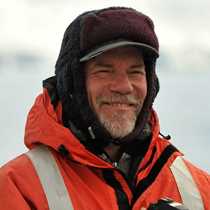At Sea
Greetings slug fans! Time again for another installment in our on-going series of nudibranch reports, this time from the cold temperate seas of Norway. The sun has been shining beautifully for the past few days and the grassy meadows that line the fiords and spread across the rocky islands of this coast are filled with lovely wildflowers. Beneath the sea summer is in full swing as well; the kelp forest is at its peak and filled with fascinating creatures.
On the blades of the kelp, colonies of bryozoans or moss-animals are growing, racing to complete their life-cycles before the kelp begins to die back as winter returns. Sometimes called kelp lace, these coordinated groups of tiny animals are prey for several species of sea slugs, including the lovely orange and white, clownlike Polycera quadrilineata. We observed one of these, happily munching away, 80 feet down in the Lofoten Islands.
Echoing the beautiful flowers in the terrestrial meadows, numerous athecate hydroids (flower-like animals related to anemones and corals) are extending their crowns of fine tentacles into the waters just above the rocky bottom, combing for the tiny plankton that is their food. In turn, these hydroids are prey for our pictured species today, the lovely and delicate Flabellina browni. Like many of its cousins in the sub-order Aeolidinae, it has the truly incredible ability to incorporate active stinging cells from the tentacles of its prey into the tissues of its own cerrata (the “gills” on the slug’s back) and use them for defense! The individual pictured has climbed out onto a very small blade of kelp, probably searching for its next flowery victim.
Greetings slug fans! Time again for another installment in our on-going series of nudibranch reports, this time from the cold temperate seas of Norway. The sun has been shining beautifully for the past few days and the grassy meadows that line the fiords and spread across the rocky islands of this coast are filled with lovely wildflowers. Beneath the sea summer is in full swing as well; the kelp forest is at its peak and filled with fascinating creatures.
On the blades of the kelp, colonies of bryozoans or moss-animals are growing, racing to complete their life-cycles before the kelp begins to die back as winter returns. Sometimes called kelp lace, these coordinated groups of tiny animals are prey for several species of sea slugs, including the lovely orange and white, clownlike Polycera quadrilineata. We observed one of these, happily munching away, 80 feet down in the Lofoten Islands.
Echoing the beautiful flowers in the terrestrial meadows, numerous athecate hydroids (flower-like animals related to anemones and corals) are extending their crowns of fine tentacles into the waters just above the rocky bottom, combing for the tiny plankton that is their food. In turn, these hydroids are prey for our pictured species today, the lovely and delicate Flabellina browni. Like many of its cousins in the sub-order Aeolidinae, it has the truly incredible ability to incorporate active stinging cells from the tentacles of its prey into the tissues of its own cerrata (the “gills” on the slug’s back) and use them for defense! The individual pictured has climbed out onto a very small blade of kelp, probably searching for its next flowery victim.




